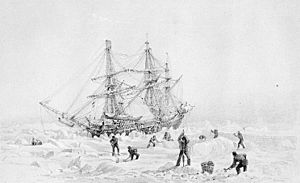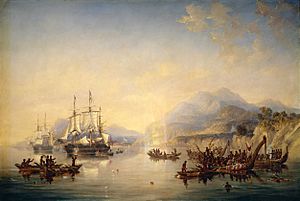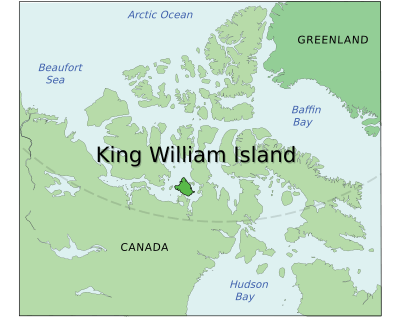HMS Terror (1813) facts for kids
class="infobox " style="float: right; clear: right; width: 315px; border-spacing: 2px; text-align: left; font-size: 90%;"
| colspan="2" style="text-align: center; font-size: 90%; line-height: 1.5em;" | 
|Abandoned: || 22 April 1848, Victoria Strait |- |Rediscovered: || 12 September 2016, Terror Bay
|} HMS Terror was a special warship built in 1813 for the Royal Navy. It was a new type of ship called a bomb vessel. This meant it was designed to fire large bombs from powerful mortars.
Terror fought in several battles during the War of 1812 against the United States. Later, it became a ship for exploring the polar regions. It went on trips to the Arctic and Antarctic. Sadly, it was lost with all its crew during Sir John Franklin's famous expedition to find the Northwest Passage in 1845. Another ship, HMS Erebus, was also lost.
On September 12, 2016, the wreck of Terror was found in Nunavut's Terror Bay. This bay is off the coast of King William Island. The wreck was found about 92 kilometers (57 miles) south of where people thought the ship was lost. It was also about 50 kilometers (31 miles) from the wreck of HMS Erebus, which was found in 2014.
Contents
| History | |
|---|---|
| Name | Terror |
| Ordered | 30 March 1812 |
| Builder | Robert Davy, Topsham, Devon |
| Laid down | September 1812 |
| Launched | 29 June 1813 |
| Completed | By 31 July 1813 |
| General characteristics | |
| Class and type | Vesuvius-class bomb vessel |
| Tons burthen | 325 (bm) |
| Length | 102 ft (31.09 m) |
| Beam | 27 ft (8.23 m) |
| Installed power | 30 Nominal horsepower |
| Propulsion | |
| Complement | 67 |
| Armament |
|
| Official name: Wrecks of HMS Erebus and HMS Terror National Historic Site | |
| Designated: | 2019 |
Building and Early Military Service
HMS Terror was built in Topsham, Devon, England. It took two years to build this special bomb ship. The ship was 31 meters (102 feet) long and weighed 325 tons. It had two large mortars and ten cannons. Terror was ready for service in June 1813.
Fighting in the War of 1812
Terror was used in the War of 1812 against the United States. The Royal Navy blocked American ports and launched attacks from its base in Bermuda. In 1814, Terror helped bombard Stonington, Connecticut.
It also took part in the Battle of Baltimore in September 1814. During this battle, Terror helped attack Fort McHenry. This attack inspired Francis Scott Key to write the poem that became "The Star-Spangled Banner". In 1815, Terror was involved in attacks on Fort Peter and St. Marys, Georgia.
After the war, Terror was stored away until 1828. It was then used again in the Mediterranean Sea. However, it was soon taken out of service for repairs after being damaged near Lisbon, Portugal.
Adventures in Polar Exploration
In the 1830s, Terror was changed to become a polar exploration ship. Its original design as a bomb ship made it very strong. This strength helped it withstand the crushing pressure of polar sea ice.
The Back Expedition to the Arctic
In 1836, Captain George Back took command of Terror. They went on an Arctic trip to Hudson Bay. The goal was to reach Repulse Bay and explore the Boothia Peninsula.
Terror got stuck in the ice near Southampton Island and could not reach Repulse Bay. At one point, the ice pushed the ship 12 meters (39 feet) up a cliff! It was trapped in the ice for ten months. In 1837, an iceberg damaged the ship even more. Terror almost sank on its way back across the Atlantic Ocean. Captain Back managed to beach the ship in Ireland on September 21.
The Ross Expedition to Antarctica

After repairs, Terror was sent on a trip to the Antarctic in 1839. It sailed with Erebus under the command of James Clark Ross. Francis Crozier was the commander of Terror on this journey.
The expedition lasted three seasons, from 1840 to 1843. Terror and Erebus explored the Ross Sea and the Weddell Sea. A volcano on Ross Island was named Mount Terror after the ship.
The Lost Franklin Expedition
Before the Franklin expedition, both Erebus and Terror were greatly changed. They were given steam engines from old trains. These engines could move the ships at about 4 knots (7.4 km/h). This made them the first Royal Navy ships with steam power and propellers.
The ships also had iron plating added to their front and back. This made them stronger against pack ice. They were loaded with supplies for three years, including tobacco, canned food, and liquor. Terror even had a library with 1,200 books.
The Search for the Northwest Passage
Sir John Franklin led the expedition, with Erebus as his ship. Captain Francis Crozier again commanded Terror. Their mission was to collect magnetic data in the Canadian Arctic. They also aimed to complete a trip through the Northwest Passage. This passage had been mapped but never fully sailed through.
The expedition left England on May 19, 1845. The ships were last seen in Baffin Bay in August 1845. Their disappearance led to a huge search in the Arctic. We now know that both ships got stuck in the ice. The crews abandoned them and tried to walk to a trading post. Sadly, all the sailors died from the cold and hunger. Later studies showed their canned food might have been unsafe due to lead and botulism.
Finding the Wreckage

In 2008, Parks Canada began a search for the two ships. They used an icebreaker called CCGS Sir Wilfrid Laurier. More searches happened in 2010, 2011, and 2012, but the ships were not found.
On September 8, 2014, one of Franklin's ships was found. It was identified as Erebus on October 1, 2014.
Discovery of Terror
On September 12, 2016, the Arctic Research Foundation announced they found a wreck that looked like Terror. It was found in Terror Bay off King William Island. The wreck was about 21-24 meters (69-79 feet) deep. The exact location is kept secret to protect the wrecks from being looted. They are now a National Historic Site of Canada.
Sammy Kogvik, an Inuit hunter, helped find the ship. He remembered seeing something like a mast sticking out of the ice years before. This information led researchers to Terror Bay, where they found the wreck in just 2.5 hours. Locals had told stories about Terror being in the bay for a long time, but these stories were not always believed.
The wreck was in amazing condition, with its decks and inside areas mostly whole. A large exhaust pipe on the deck helped identify the ship. It was in the same spot where Terror's steam engine smokestack had been. The wreck was found almost 100 kilometers (62 miles) south of where historians thought it would be. This makes people rethink what happened to the sailors.
The location and signs of anchor use suggest the ship was still being used. This raises the idea that some sailors might have tried to sail the ship home.
In 2017, the British government decided to give Terror and Erebus to Canada. They kept only a few small items and the right to bring back any human remains. In 2018, the ships were officially given to Canada and the Inuit, cared for by the Inuit Heritage Trust.
In August 2019, Parks Canada explored Terror using ROVs. They mapped 90 percent of the lower deck. They hope to find written materials in Captain Crozier's cabin, which is very well preserved. Plans for more exploration in 2020 were canceled due to the COVID-19 pandemic.
Legacy and Namesakes
- Mount Terror on Ross Island in Antarctica was named after the ship by Captain Ross. He also named a nearby peak Mount Erebus.
- Erebus and Terror Gulf in Antarctica is named for the ships.
- Terror Bay on King William Island was named in 1910, long before the wreck was found there.
- Terror Rupes is a cliff on the planet Mercury.
Images for kids
See also
 In Spanish: HMS Terror (1813) para niños
In Spanish: HMS Terror (1813) para niños




